
 |
|||||
|
|
|||||
|
|
|
|||||
|
|
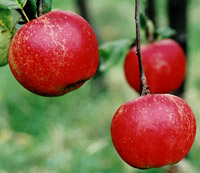 |
GASCOYNE’S SCARLET Raised by Mr Gascoyne of Bapchild Court, Sittingbourne, Kent and introduced by George Bunyard’s Nursery in 1871. Large, crisp, juicy sweet fruit also renowned for its stunning, all over red appearance. Primarily an eating apple it can also be used for cooking, when it will break up completely and retain a fruity flavour It is a vigorous tree and partially tip bearing. Very attractive blossom T. Pollination Group 5 |
||
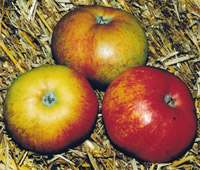 |
GENET MOYLE An old cider apple, known since at least 1600, and especially popular in Herefordshire. It makes a light, sweet cider and the flesh is slightly tannic, but it is also a pleasant dessert apple and when cooked it makes a rich, lemony purée. It is also valued for baking. Brightly coloured fruit, with a golden skin, striped and flushed with scarlet. Good crops, ripe in September and lasting to December. Part tip bearing. T. Pollination Group 2 |
|||
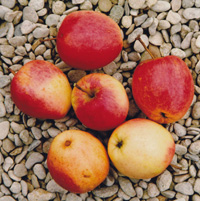 |
GENITON
Pauline and Julian Webster’s former home in Amersham, Buckinghamshire,
was populated with some rare local varieties of apple, around 1926, shortly
after the completion of its being built. The previously unknown Buckinghamshire
Sheep’s Nose came from there. Another apple tree was growing in
the shade of now mature ornamentals and had not noticeably fruited for
many years. Pauline Webster had written down the name of this tree as
Geniton or Jeniton, from a telephone conversation with the previous owner
(and first owner) of the property, at the time they took it over. A few
years ago we took cuttings and trees have now fruited here for the past
two years. The original tree has now gone, to make way for a house extension
for the new owners coming after the Websters. Though the name Geniton
is a known synonym of Joaneting, this apple is not the same. It is not
quite like other apple trees, having a more slender growth habit and dense
clusters of both flowers and apples, between an ornamental crab and a
normal domestic apple tree. Though many ornamental and species crabs are
quite pleasantly edible, this tree does not appear to be any of them and
the fruit, though small, is more on the side of a domestic apple. The
blossom is impressive enough, and is slightly fragrant, but when the brightly
coloured fruits hang in dense clusters, the show is spectacular. The individual
fruits are small, longer than wide and conical with bright red stripes
and broader carmine blushes, maturing to cerise, over a yellow skin. They
are crisp, juicy, sweet and with a rather delicate floral taste when just
ripe. The flesh is fine textured and tends to be a little translucent.
Depending on the warmth of the summer, they are ripe between mid-August
and mid September, but will not last in any worthwhile state beyond the
end of October. A beautiful tree, in blossom or in fruit, and with prolific
crops of very good small apples. We are grateful to Pauline and Julian
Webster for pointing us to it. Pollination Group 3 |
|||
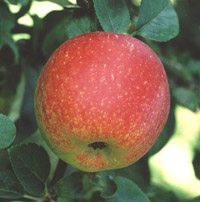 |
GEORGE CARPENTER A handsome, mid-season dessert apple introduced in Surrey in 1902 and named after its raiser. A cross between Blenheim Orange and King of the Pippins, having firm flesh and a rich flavour. It keeps until November. Pollination Group 5 | |||
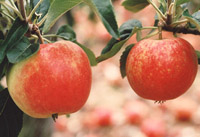 |
GEORGE
CAVE Introduced by Seabrook’s Nursery of Essex in 1945,
though it had been raised by George Cave in 1923. An early dessert apple,
which is ready in mid-August, with small to medium sized fruit, flushed
red and with crisp, sweet and juicy flesh. The crops are good and the
apples colour well, developing an intense flavour in warm summers. The
blossom is said to withstand frost. It does not store for long. Pollination
Group 3 |
|||
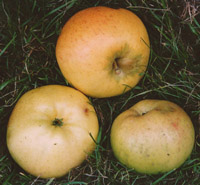 |
GEORGE
NEAL An early culinary or dessert apple, raised in 1904 by Mrs
Reeves of Otford in Kent, and introduced in 1923 by R. Neal and Sons of
Wandsworth. The yellow/green apples are flushed with scarlet and have
russet spots. They are crisp and juicy and keep their shape well when
cooked. The trees have attractive blossom and crop well. Very rich for
an early apple, ripe in late August, but it does not last beyond November.
Pollination Group 3 |
|||
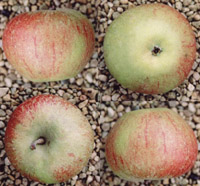 |
GEORGE
NEILSON Another old variety which was assumed extinct in Britain,
but which we rediscovered in the Grove Heritage Collection, in Tasmania.
They sent us scions in 2005. The only record we have of it says that it
was grown in Scotland and received by the National Fruit Trials in 1939.
Their tree failed and there has been no word of it since. It fruited here
in 2006 and turns out to be a very good apple indeed. It is a medium sized,
truncate conic, smoothly rounded apple, quite flattened, with a small
eye, very open, in a wide shallow basin. The stalk is short and obliquely
set. The glossy skin is pale green with many thin red streaks, where exposed
to the sun, sometimes more widely red. It can be thinly russeted, especially
at the stalk and with russet flecks on the body. It is sweet, with a rich
flavour, crisp and juicy. Fruit is ripe in early October and will store
for a few months. It seems to be a regular cropper. Pollination Group
4 |
|||
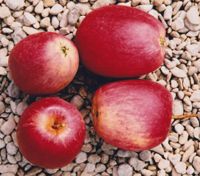 |
GILLIFLOWER
A very old English apple dating at least from Parkinson in 1629. He said
of it “The Gilloflower apple is a fine apple, and finely spotted.”
Forsyth in 1810 says of it “The Gilliflower is a fine handsome Apple,
red towards the sun, and of a yellowish-green on the other side. It is
of a fine flavour, and keeps till the latter end of March.” Hogg
reported it as a large ribbed, conical, codlin shaped, culinary apple,
though quite sweet, in use in October. It was known to exist in 1884 but
has not been recorded in Britain since. Discovering it in the collection
of the U.S. Department of Agriculture at New York, we grafted the first
new trees in 2005, upon receiving scionwood from there. It has historically
been grown from Cumberland to Kent. A very beautiful apple – long
and rounded, with almost all the skin flushed and streaked with deep crimson.
The flesh is sweet, fairly juicy and rich. Part tip bearing. Pollination
Group 5 |
|||
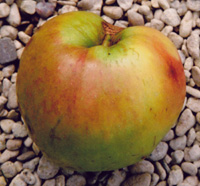 |
GILMOOR
DUMPLING When artist Sally Maynard moved to Gilmore Farm, Brushford,
Dulverton, West Somerset, in 1982, she inherited several fruit trees but
her favourite was a ‘dumpling apple’, one that softened completely
on cooking and was often wrapped in pastry, cooked and taken to work.
The farm dated from 1681 in the ‘Restoration’ period and was
originally called Gilmoor Farm (not Gilmore) hence the name for this apple
now. Sally asked us in 2008 how she could identify the variety and multiply
it. Identification of old cooking apples is far from easy, but as time
went on a DNA test found it unmatched. She sent a photo of the tree and
it was certainly a true veteran. Sally sent us apples and scionwood, informing
us that the apples weighed a pound and that in one year she had collected
three hundredweight of apples. That is nearly a sixth of a ton. The apples
ripen over a period but have all dropped by the end of October when the
leaves fall and they do not store for more than a few weeks, as is common
with the lighter textured dumpling apples. West Somerset tends to be rather
damp and many varieties do not thrive there, but this one does. We found
that the apples instantly cooked to a froth and were very sweet and very
rich. The crops can be so heavy that young trees would need support and
old trees would tend to bow to the ground! Pollination Group 3 |
|||
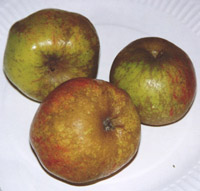 |
GIPSY
KING A nineteenth century dessert apple, recorded in 1872, without
description, in a list, in Scott’s ‘The Orchardist’.
It was in the catalogue of Thomas Rivers in 1876. The accession in the
National Collection, the same as that offered here, has now been removed
by them, under the assumption that it is not the true original, and that
it does not accord with the most complete description available, in the
Herefordshire Pomona of 1876-85. But this same apple, here, appears very
close to that description and we are inclined to believe it is the true
original. It is an attractive fruit, small to medium sized, round, to
flattened, to slightly conical, and with greenish-yellow skin, overlaid
with golden russet and streaked red with wider flushes of broken deep
carmine. The flesh is firm, juicy and with a rich flavour. It ripens in
mid October and will store until Christmas. An attractive and enjoyable
fruit. Pollination Group 6 |
|||
|
||||